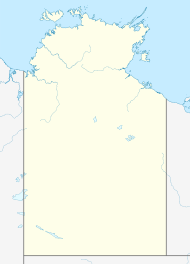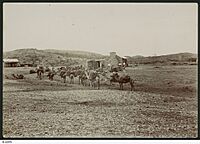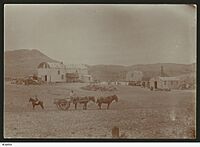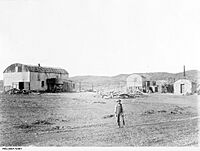Arltunga Historical Reserve facts for kids
Quick facts for kids Arltunga Historical ReserveHart, Northern Territory |
|
|---|---|
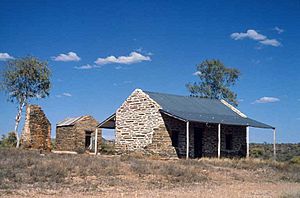
The Arltunga Gaol at the Arltunga Historical Reserve
|
|
| Managing authorities | Parks and Wildlife Commission of the Northern Territory |
Arltunga Historical Reserve, also known as Arnerre-ntyenge, is a deserted gold rush town in the Northern Territory of Australia. It is located in a place called Hart, about 110 kilometres (68 miles) east of Alice Springs. This important historical site sits on the traditional lands of the Eastern Arrernte people.
The name Arltunga comes from the Eastern Arrernte name for a nearby waterhole, Arnerre-ntyenge. This name roughly means 'stinking water'. It got this name because animals sometimes got stuck and died there. Another idea is that the name comes from a different Aboriginal language, Kukatja, meaning 'easterners'. Europeans called this waterhole Paddy's Rockhole.
Arltunga is very important because it was the first big European settlement in Central Australia. It is also close to the Winnecke Goldfield, which had a similar history.
Contents
The Eastern Arrernte People
The Eastern Arrernte people are the traditional owners of the land where Arltunga Historical Reserve is. They call this place Arnerre-ntyenge. This area has been their home for thousands of years.
When European settlers arrived, the Eastern Arrernte people played a big part in their survival. Many Aboriginal people believed that by helping the gold prospectors, they could keep some of their independence. The Eastern Arrernte people worked as guides, trackers, labourers, miners, messengers, and helped in homes. They also shared their knowledge of the land, especially about water sources and bush food.
Many Eastern Arrernte people also worked on nearby cattle stations. These included places like Atnarpa, Loves Creek, Ambalindum, and The Gardens.
Gold Mining History
Gold was first seen here by an explorer named David Lindsay in 1887. He found it in the creek sands below Paddy's Rockhole (Arnerre-ntyenge). This discovery happened after he found what he thought were 'rubies' at Ruby Gap in 1886. These were later found to be high-quality garnets.
After gold was found, many miners rushed to the area. Arltunga quickly became the first important European town in Central Australia. To help supply Arltunga with goods, Lindsay was asked to plan the town of Stuart, which is now Alice Springs.
In 1898, the government built the Government Battery and Cyanide Works. These were special machines used to process gold. James Gilbert Woolcock managed the building of these works, even though it was very difficult to get materials there. The next year, in 1899, a police station and other buildings were constructed by William Hurle Liddle and Gerhardt Johannsen.
However, Arltunga faced many challenges. A severe drought in the 1890s caused wells to dry up. Horses were too weak to carry the ore (rock with gold in it). In 1901, the gold-processing machine broke for several months. Things got better in 1903 when new gold was found at the nearby Winnecke Goldfield. This brought more interest to the area. By 1905, a new well, store, and hotel were built there. Around the year 1900, about 350 to 400 people lived in the goldfield area.
In the late 1920s and early 1930s, new gold discoveries were made at The Granites and Tennant Creek. Many miners left Arltunga to go to these new places. Arltunga still had problems getting enough water. By 1933, the population had dropped to only 25 people.
The Mission
The Little Flower Mission, run by the Missionaries of the Sacred Heart, moved to Arltunga in 1944. By this time, most people had left the town. The mission was renamed Arltunga Mission. It had been in Alice Springs before, but it moved because there were many Army people in Alice Springs during World War II. A lay missionary named Francis McGarry helped a lot with this move. He also chose the new site. Soon after the move, McGarry left the mission.
The mission moved again in 1953 to a place called Phillipson's Block. It was then renamed Santa Teresa Mission. Today, this is known as the community of Ltyentye Apurte.
Recent History
Arltunga Historical Reserve was officially created in 1975. It covers an area of 5,000 hectares (about 12,355 acres). Because the weather is very harsh and local stone was used to build the buildings, the old town is still quite well preserved.
The reserve was suggested for heritage listing in 2008. This means it would be recognized as an important historical place. The Government Battery and Cyanide Works part of Arltunga was successfully listed in 1995. However, the rest of the reserve's listing was delayed until 2014. This was because of a native title claim in the area. In 2014, the rest of the reserve was successfully listed.
The reserve was also listed on the former Register of the National Estate.
Gallery
You can find more images in the Arltunga Collection at the State Library of South Australia.
Notable People
Many interesting people were connected to Arltunga:
- A Chinese market gardener named Ah Hong often traveled to Arltunga. He brought fresh vegetables and food for the miners.
- Bushman Ben Nicker was born just north of the Arltunga goldfields.
- Gwoya Tjungurrayi and his family came to the Arltunga area after the Coniston massacre. He later worked as a gold miner there.
- Hetty Perkins, who worked at The Bungalow for many years, was born at Arltunga.
- Topsy Smith and her husband, William "Bill" Smith, lived at the Arltunga Goldfields for a long time. Their son Walter Smith also spent much of his early life there.
- Policeman William George Murray moved to Arltunga in 1931. He became the Mining Warden and later, in 1936, the health inspector. In 1937, he was investigated for selling government property without permission. He was found not guilty in court. After this, he was moved to Roper River in 1938.
Cemeteries
There are two cemeteries (places where people are buried) within the Arltunga Historical Reserve:
- Crossroads Cemetery
- White Range Cemetery
Climate
| Climate data for Arltunga, elevation 661 m (2,169 ft), (2000–2020 normals, extremes 2000–present) | |||||||||||||
|---|---|---|---|---|---|---|---|---|---|---|---|---|---|
| Month | Jan | Feb | Mar | Apr | May | Jun | Jul | Aug | Sep | Oct | Nov | Dec | Year |
| Record high °C (°F) | 43.9 (111.0) |
43.7 (110.7) |
41.6 (106.9) |
39.0 (102.2) |
33.4 (92.1) |
30.2 (86.4) |
30.4 (86.7) |
35.0 (95.0) |
39.0 (102.2) |
41.0 (105.8) |
42.5 (108.5) |
44.5 (112.1) |
44.5 (112.1) |
| Mean daily maximum °C (°F) | 36.2 (97.2) |
34.7 (94.5) |
32.4 (90.3) |
29.1 (84.4) |
23.2 (73.8) |
19.5 (67.1) |
20.2 (68.4) |
23.0 (73.4) |
27.8 (82.0) |
31.3 (88.3) |
33.8 (92.8) |
34.7 (94.5) |
28.8 (83.9) |
| Mean daily minimum °C (°F) | 22.3 (72.1) |
21.1 (70.0) |
18.6 (65.5) |
13.4 (56.1) |
8.1 (46.6) |
4.3 (39.7) |
3.1 (37.6) |
4.7 (40.5) |
10.2 (50.4) |
14.3 (57.7) |
18.1 (64.6) |
20.4 (68.7) |
13.2 (55.8) |
| Record low °C (°F) | 10.0 (50.0) |
8.6 (47.5) |
6.9 (44.4) |
1.5 (34.7) |
−4.2 (24.4) |
−5.0 (23.0) |
−6.5 (20.3) |
−5.0 (23.0) |
−0.9 (30.4) |
0.0 (32.0) |
6.6 (43.9) |
7.5 (45.5) |
−6.5 (20.3) |
| Average rainfall mm (inches) | 65.0 (2.56) |
57.8 (2.28) |
33.6 (1.32) |
18.6 (0.73) |
18.5 (0.73) |
14.0 (0.55) |
9.2 (0.36) |
4.4 (0.17) |
10.5 (0.41) |
23.4 (0.92) |
32.9 (1.30) |
52.6 (2.07) |
340.5 (13.4) |
| Average rainy days (≥ 1.0 mm) | 4.3 | 3.7 | 2.1 | 1.2 | 1.9 | 1.5 | 1.2 | 0.8 | 1.5 | 2.8 | 4.0 | 5.3 | 30.3 |
| Source: Australian Bureau of Meteorology | |||||||||||||


